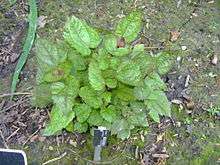Ageratina luciae-brauniae
| Ageratina luciae-brauniae | |
|---|---|
 | |
| Scientific classification | |
| Kingdom: | Plantae |
| (unranked): | Angiosperms |
| (unranked): | Eudicots |
| (unranked): | Asterids |
| Order: | Asterales |
| Family: | Asteraceae |
| Tribe: | Eupatorieae |
| Genus: | Ageratina |
| Species: | A. luciae-brauniae |
| Binomial name | |
| Ageratina luciae-brauniae (Fernald) King & H.Rob. | |
| Synonyms[1][2] | |
| |
Ageratina luciae-brauniae is a species of flowering plant in the aster family known by the common names Lucy Braun's snakeroot and rockhouse white snakeroot. It is native to the eastern United States, where it is limited to the Cumberland Plateau of Kentucky and Tennessee.[3][4] It may also occur in South Carolina but these reports are unconfirmed.[5]
This perennial herb grows 30 to 60 centimeters tall. It has oppositely arranged leaves with thin oval or somewhat triangular blades up to 8 centimeters long by 9 wide. The inflorescence is a cluster of flower heads containing white disc florets and no ray florets.[6]
This plant grows in rockhouses, sandy spaces under overhangs of sandstone rock. It grows in moist places where water drips off the rock above.[3]
There are about 40[3] to 50[5] occurrences of the plant. Some populations in Kentucky are large but many are composed of just a few plants.[3]
The plant was initially described in 1940 by American botanist Dr. Emma Lucy Braun, using the name Eupatorium deltoides.[7] This name turned out to have been used three times before,[2] so it needed to be replaced with a new name. Merritt Lyndon Fernald dubbed it Eupatorium luciae-brauniae after Dr. Braun(1889-1971).[8]
See also
References
- ↑ The Plant List Ageratina luciae-brauniae (Fernald) R.M.King & H.Rob.
- 1 2 The International Plant Names Index search for Eupatorium deltoideum
- 1 2 3 4 Ageratina luciae-brauniae. The Nature Conservancy.
- ↑ Biota of North America Program 2014 county distribution map
- 1 2 Ageratina luciae-brauniae. Archived October 26, 2011, at the Wayback Machine. Center for Plant Conservation.
- ↑ Ageratina luciae-brauniae. Flora of North America.
- ↑ Braun, Emma Lucy 1940. Rhodora 42(494): 50–51 description in Latin, commentary in English
- ↑ Fernald, Merritt Lyndon 1942. Rhodora 44(528): 463
